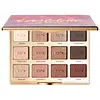Tarte Tartelette Amazonian Clay Eyeshadow Palette Versus Makeup by Mario Master Mattes Eyeshadow Palette
What's inside
What's inside
 Key Ingredients
Key Ingredients

 Benefits
Benefits

 Concerns
Concerns

 Ingredients Side-by-side
Ingredients Side-by-side

Talc
AbrasiveMica
Cosmetic ColorantSilica
AbrasiveZinc Stearate
Cosmetic ColorantBoron Nitride
AbsorbentEthylhexyl Palmitate
EmollientSodium Dehydroacetate
PreservativeCaprylyl Glycol
EmollientPhenoxyethanol
PreservativeVanillin
MaskingCaprylic/Capric Triglyceride
MaskingHexylene Glycol
EmulsifyingVanilla Planifolia Fruit Extract
Skin ConditioningKaolin
AbrasiveCI 75470
Cosmetic ColorantCI 77891
Cosmetic ColorantIron Oxides
CI 77742
Cosmetic ColorantCI 77163
Cosmetic ColorantCI 77510
Cosmetic ColorantCI 77007
Cosmetic ColorantCI 77400
Cosmetic ColorantTin Oxide
AbrasiveTalc, Mica, Silica, Zinc Stearate, Boron Nitride, Ethylhexyl Palmitate, Sodium Dehydroacetate, Caprylyl Glycol, Phenoxyethanol, Vanillin, Caprylic/Capric Triglyceride, Hexylene Glycol, Vanilla Planifolia Fruit Extract, Kaolin, CI 75470, CI 77891, Iron Oxides, CI 77742, CI 77163, CI 77510, CI 77007, CI 77400, Tin Oxide
 Reviews
Reviews

Ingredients Explained
These ingredients are found in both products.
Ingredients higher up in an ingredient list are typically present in a larger amount.
This ingredient is an emollient, solvent, and texture enhancer. It is considered a skin-softener by helping the skin prevent moisture loss.
It helps thicken a product's formula and makes it easier to spread by dissolving clumping compounds.
Caprylic Triglyceride is made by combining glycerin with coconut oil, forming a clear liquid.
While there is an assumption Caprylic Triglyceride can clog pores due to it being derived from coconut oil, there is no research supporting this.
Learn more about Caprylic/Capric TriglycerideCaprylyl Glycol is a humectant and emollient, meaning it attracts and preserves moisture.
It is a common ingredient in many products, especially those designed to hydrate skin. The primary benefits are retaining moisture, skin softening, and promoting a healthy skin barrier.
Though Caprylyl Glycol is an alcohol derived from fatty acids, it is not the kind that can dry out skin.
This ingredient is also used as a preservative to extend the life of products. It has slight antimicrobial properties.
Learn more about Caprylyl GlycolCi 75470 is a bright-red pigment. It is AKA carmine.
Carmine is derived from insects such as the cochineal beetle. This ingredient has been used as a natural dye for over 2000 years.
Ci 77891 is a white pigment from Titanium dioxide. It is naturally found in minerals such as rutile and ilmenite.
It's main function is to add a white color to cosmetics. It can also be mixed with other colors to create different shades.
Ci 77891 is commonly found in sunscreens due to its ability to block UV rays.
Learn more about CI 77891Silica, also known as silicon dioxide, is a naturally occurring mineral. It is used as a fine, spherical, and porous powder in cosmetics.
Though it has exfoliant properties, the function of silica varies depending on the product.
The unique structure of silica enhances the spreadability and adds smoothness, making it a great texture enhancer.
It is also used as an active carrier, emulsifier, and mattifier due to its ability to absorb excess oil.
In some products, tiny microneedles called spicules are made from silica or hydrolyzed sponge. When you rub them in, they lightly polish away dead skin layers and enhance the penetration of active ingredients.
Learn more about SilicaTalc is a clay mineral. It helps absorb moisture and improve the texture of products. Like other types of clay, Talc can have a slight exfoliating effect on skin. Talc can be added to increase the volume of products.
Some Baby powders are made by combining talc with corn starch. The word "talc" comes from Latin and originates from Arabic. Talc is a mineral commonly found throughout the world.
If you have any concerns about using talc, we recommend checking out the FDA's official page.
Learn more about TalcZinc Stearate is the metal salt of stearic acid. It is a white solid used to bind, thicken, and lubricate products.
This ingredient is common in powder makeup, where it helps keep the powder together.
Zinc Stearate is hydrophobic and repels water.
This ingredient can be sourced from non-animal or animal sources. It is best to reach out to the brand to see where they source this ingredient from.
Learn more about Zinc Stearate